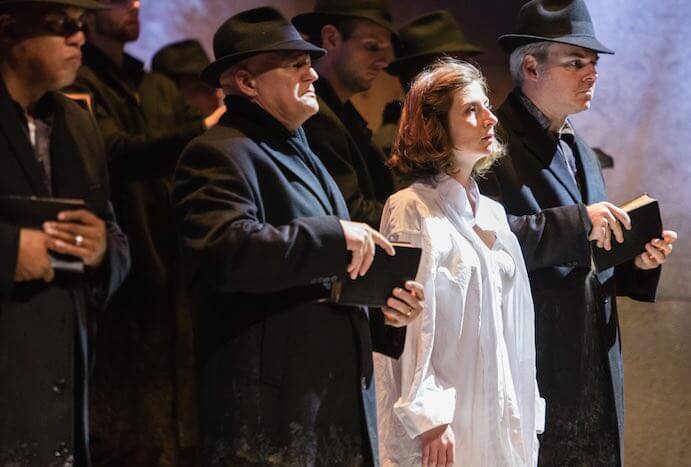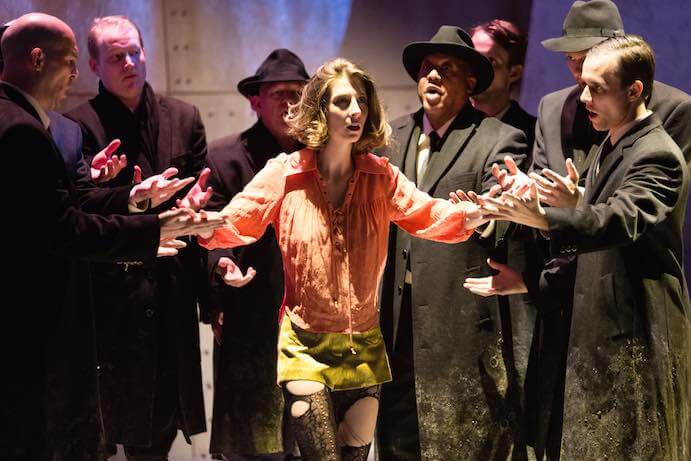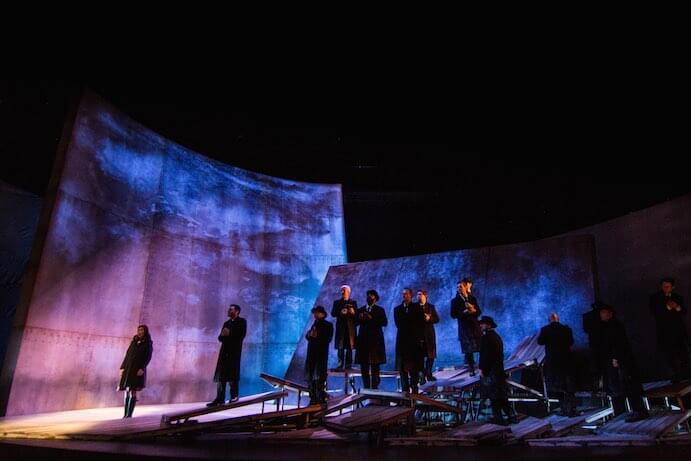On Saturday, September 24, 2016, the curtain of the Perelman Theater rose in silence for the world premiere run of Missy Mazzoli and Royce Vavrek’s chilling new opera Breaking the Waves at Opera Philadelphia. The set, a collection of fractured beams and wooden platforms, was bathed in a light that gave the illusion of waves pulsating along a jagged coastline. A group of uniformly dressed men stood with their backs turned to the audience, which cast an appropriately foreboding mood on the intimate performance space. After a moment of stillness to absorb the scene, the 15-piece orchestra entered with a foundation of lush chords from which angular bursts emerged—a brilliant sonic representation of the visual imagery.
Based on the 1996 Academy Award-nominated film by Lars von Trier, Mazzoli and Vavrek’s Breaking the Waves is likewise set in the early 1970s on the Isle of Skye, Scotland and chronicles the trials and ultimate downfall of Bess McNeill. Bess falls in love with Jan Nyman, an off-shore oil rigger, even though he is viewed as an outsider by the strict local Calvinist church. After their wedding, Jan’s return to the oil rig forces Bess into a deep depression, and in her conversations with God, she prays that Jan will return. Jan is subsequently involved in a near-fatal accident on the oil rig and returns home almost completely paralyzed. Bess believes the accident to be her fault while Jan attempts to liberate her. Jan instructs Bess to find men for sexual encounters and to report back to him so that it will feel like they are together. Upon carrying out his wishes, her reputation is destroyed and she is excommunicated from the church. The encounters escalate until Bess is brutally raped and mutilated in an ultimate act of sacrifice while Jan’s health is miraculously restored.

Breaking the Waves–Photo by Dominic M. Mercier
The three most powerful components of this production are the depiction of mob mentality, conflicting ideas of truth and goodness, and the malleability of Bess’s character. Mazzoli has likened the narrative of Breaking the Waves to Benjamin Britten’s Peter Grimes, and this parallel is immediately apparent in her treatment of the chorus. Like Peter Grimes, Breaking the Waves deals with the concept of an individual versus society. The chorus in this production shifts from the church elders to oil rig workers to members of the community with which Bess has various sexual encounters. Mazzoli’s writing for the chorus—particularly in their role as the church elders—is often monophonic and chant-like with punctuated diction. When she introduces harmony, the text setting remains homorhythmic and occasionally suggests chorale-style hymn singing. The resulting music is highly effective in communicating the force of a unified group against an individual.
The preference for homorhythmic writing also provides stark contrast to the moments where the mob dissolves into chaos both textually and musically. The two most striking deviations from the unified choral singing of the church elders occur in Act II (“Wives, submit yourselves, Unto your husbands, as unto the Lord.”) and Act III (“Who’s a tart,” sung while flinging bibles at Bess). Both of these scenes feature imitative and heterophonic cries from individuals that become increasingly incoherent as more people join, resulting in a cacophony of wild voices.

Breaking the Waves–Photo by Dominic M. Mercier
Regarding the concept of “goodness,” Mazzoli and Vavrek have both asserted in interviews that they believe each character in this complex narrative is genuinely doing what they believe is best with no ulterior motives. However, this results in conflicting ideas of “goodness,” which are reflected in the timbres of both the instrumental and vocal writing. Mazzoli’s orchestration is fresh and innovative in its instrumentation and use of compelling textures. The compact 15-piece orchestra includes harp, synthesizer, and electric guitar in addition to the more conventional violin, viola, cello, bass, flute, oboe, clarinet, bassoon, french horn, trombone, and percussion. Throughout, contrasting instrumental timbres appear to mirror conflicting ideas of what is good, necessary, or right. This wide spectrum of timbres includes harmonics, tremolos, and sul ponticello playing in the strings; use of auxiliary woodwinds such as piccolo and contrabassoon; flutter tonguing and glissandi in the brass; and a percussion book that runs the gamut from scraping the inside of a brake drum to playing melodica.

Missy Mazzoli and Royce Vavrek
Contrasts in vocal timbre are almost exclusively reserved for the character of Bess. Brilliantly sung by the powerful and riveting Kiera Duffy, Bess is perhaps the most influenced by the conflicting ideas of goodness around her. While most of the other characters are firmly rooted in their own opinions, Bess unsuccessfully attempts to reconcile these disparate threads of advice. The resulting fractured character is musically striking in terms of both composition and performance. Singing from her own perspective, Bess’s voice is often blissfully melodic despite complex accompanying harmonies. As she addresses God (‘Dear God: I thank you for the greatest gift, The gift of Jan.”), Bess’s writing is light and ethereal, accompanied by high strings and piano. However, as Bess channels the voice of God through her own speech, the vocal register drops and the accompaniment shifts to brass and low strings. Duffy’s crystalline soprano represented Bess’s inner monologue, while her use of a deep, sprechstimme-like tone represented internalized opinions of the church, community, family, and God. Duffy’s command of an amazing spectrum of vocal timbres was easily one of the most impressive aspects of the performance.
The audience for the Philadelphia performances included attendees young and old, which is not only encouraging for the future of contemporary opera but also a testament to the achievements of Mazzoli and Vavrek. Though the world premiere run by Opera Philadelphia has concluded, Breaking the Waves is scheduled for the 2017 Prototype Festival in New York City, and it is a must-see production.





















